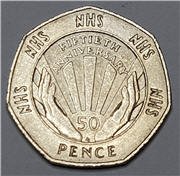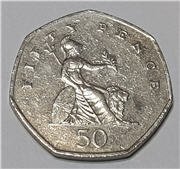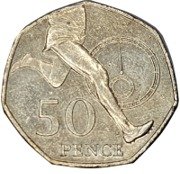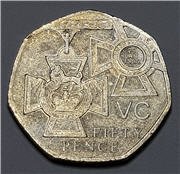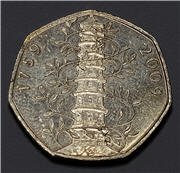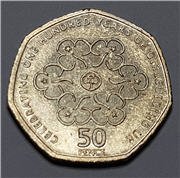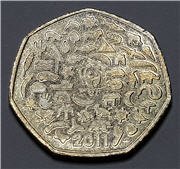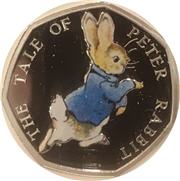
The British Fifty Pence (50p) coin was introduced in October 1969 as part of the decimalisation of the British currency. It replaced the 10 shilling note, both being equivalent to half of one pound (£0.50). It is colloquially called the '50 pee'. The coin has 7 sides (heptagonal) but has rounded corners on each apex so that the coin will roll and work in vending machines. 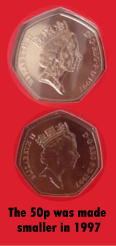 Originally, the coin has a diameter of 30mm and weighed 13.5g, but in 1997 this was replaced with a smaller version of diameter 27.3mm and weight of 8g. The thickness was kept at 1.78mm. The coin is made of Cupro-Nickel (75% copper, 25% nickel). The larger version was demonitised (i.e. ceased to be legal tender) in 1998.
Originally, the coin has a diameter of 30mm and weighed 13.5g, but in 1997 this was replaced with a smaller version of diameter 27.3mm and weight of 8g. The thickness was kept at 1.78mm. The coin is made of Cupro-Nickel (75% copper, 25% nickel). The larger version was demonitised (i.e. ceased to be legal tender) in 1998.
All coins have an obverse featuring the portrait Queen Elizabeth II. There are three versions:
- 1985-1997 - Designer: Raphael Maklouf
- 1998-2015 - Designer: Ian Rank-Broadley FRBS
- 2015 to date - Designer: Jody Clark
The reverse has shown a large variety of important UK milestones or people, and in doing so has made the coin very popular with collectors. Besides the coins intended for circulation, the Royal Mint have issued silver (normal and Piedfort), platinum and gold proof versions of the 50 pence piece.
There are also 29 different variants which were minted in 2011 in celebration of the 2012 Summer Olympics.

